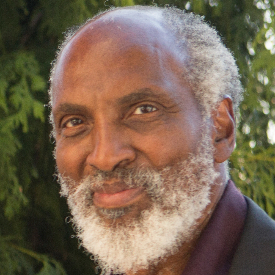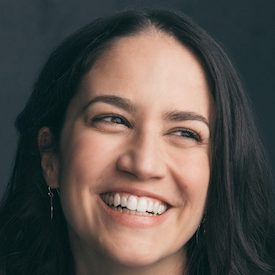john powell is a professor of law, African American studies, and ethnic studies at the University of California Berkeley, where he is also Director of the Othering & Belonging Institute. He is a cofounder of the Poverty & Race Action Council and an internationally respected expert on civil rights, racial identity, fair housing, poverty, and democracy.
What’s the big idea?
Bridging is an invitation to reject a future organized around division and fear and instead to call into being a world where we recognize our connection with one another and the Earth. The practice of bridging divides—big and seemingly small—can create the conditions and relationships for building positive change.
Below, john shares five key insights from his new book, The Power of Bridging: How to Build a World Where We All Belong. Listen to the audio version—read by john himself—in the Next Big Idea App.

1. We are made of stories, and bridging is a story.
We are meaning-making animals, and stories are the tools we use to make meaning. Stories help us make sense of the world and ourselves.
What do stories have to do with bridging? A better question may be, what do stories have to do with us? The world is not here solely to be observed. We are a part of this world and are constantly reinterpreting ourselves and our story in it. Being aware of the stories we tell about ourselves and other people creates a foundation and container where bridging might occur.
We live in a time when at least three competing stories seek to guide us. The first story is that no real change is happening, and everything will continue just as it is…this is the least credible story.
The second story is that we are heading for a future where things could get much worse. Who we are, our very way of life, is up for grabs. If we do not do something quick, and possibly extreme, it will be too late. In this story, the central factor shaping our collective anxiety is the other—the dreaded other is put forth as the most immediate and profound threat to our way of life. The main theme is them versus us. We hear they are threatening us, taking our jobs, bringing crime to communities, and importing strange religious practices. They threaten who we are. This threat may even mean extinction: we may die, be replaced, or be changed so much as to be unrecognizable. This is what I call a breaking story.
Then there is the third story. This story is about potentially good changes, a future where we all belong. In this story, we will be a more diverse and connected people. We will listen to each other and contribute our unique histories. We will work together to create structures and societies where we can all participate, celebrating our differences instead of pretending we are all the same. This is what I call a bridging story.
The second and third stories will likely be the dominant ones shaping the rest of this century. The bridging story is rooted in belonging, where we treat everyone as the same and where everyone has the agency to shape the world. We will recognize that we have more in common than we do differences and create new commonalities. I believe you and I can, and should, participate in writing the story of the future we want to see emerge. Bridging will help us all become authors.
2. Othering is the problem.
Othering is the problem of the 21st century. It is about seeing people not only as different, but as less deserving and not of equal dignity. Many of our most pressing problems share an underlying common structure, whether we call those problems racism, ethno-nationalism, homophobia, or cancel culture. Othering may seem natural or inevitable, but it is neither. Ideas based on inevitability, biological determinism, or hard-wired tribalism fail to fully capture what’s going on in the world today.
“It is about seeing people not only as different, but as less deserving and not of equal dignity.”
I believe much of othering is in service to belonging. Rather than being a cause for despair, this fact makes othering a space where we can engage. If the most fundamental need is to belong, then we have more possibilities to build for and toward belonging and to organize ourselves in ways that counter the realities of othering, such as war, poverty, racism, ableism, or the climate crisis. Even if we accept that othering is not inevitable, we still must do something in a world where the realities of othering are all around. This is where bridging comes in.
3. Belonging is a paradigm shift.
The solution I offer to othering is belonging— but without more othering. There are many practices and ideologies that embrace the notion that all members belong, and nonmembers don’t belong. But belonging without othering moves us into a new paradigm.
Belonging means having the right to fully participate in and co-create the world you live in. Belonging means your story is fully seen and valued. Belonging means having the right to make demands on systems and structures. Belonging is being respected as an equal human being with full dignity.
In the United States, we have been on a journey since our formation as a nation. Our practices started with a small we living in an exclusionary society, moved toward a partially integrated society, progressed further to an inclusive society, and now we are growing toward a belonging society. At least that’s my aspiration, and I think bridging can help us get there.
Can we imagine a future where all belong? We can and must, but we can only do it together. Much of what happens in the future depends on us. Bridging helps us cultivate practices that guide a new story where no person is left out of our circle of concern.
4. There are different types of bridging.
Deciphering the types of bridges refines our practice of bridging. There is bridging that is transactional, that is transformational, and there is bridging that is an expression of profound spiritual aspirations. There are bridges between loved ones and family, and bridging between individuals and groups. There are short bridges, and there are long bridges.
I don’t suggest you start bridging with whoever is at the furthest reach of your imagination. Start with someone closer. Start with a short bridge. A short bridge is a bridge where the parties in the groups already share a good deal. They may be friends or family. They may belong to the same religious institution or political party. Despite sharing many things, like language or values, there are still disagreements. To an observer, these disagreements might seem petty. If there is a need for a bridge, it seems short. And yet, even short bridges can be difficult to build and, if not handled well, can break otherwise healthy relationships.
Groups with much in common often agree on important goals or an end destination but strongly disagree on the strategy for getting there. At times, familiarity can add to a break’s intensity. Family members or good friends know how to hurt one another in ways not so available to a stranger. Maybe we should not be surprised that in the United States, the Civil War still stands out of all U.S. conflicts as the deadliest.
“Family members or good friends know how to hurt one another in ways not so available to a stranger.”
Long bridges may not feel possible to either build or cross. Who in our own story and imagination is the person or group that threatens our very existence? The other in that story is at the opposite end of a long bridge. People usually have little trouble identifying who represents the other on the opposite side of that long bridge. It is the devil. Or maybe the Trump supporter if I am voting Democrat, or the Democrat if I am for Trump.
Unless the person or group on the other side of the long bridge is someone with whom I have already had close contact, I am likely to know them only in terms of the worst details of their lives—a lens that sheds very little information or nuance. The details we can make out at this distance are not likely to be endearing or attractive. Long bridges are more likely to come into play at the group level or higher, such as state or international levels.
Despite the challenge, hopeful interventions exist. Many groups that organize around long bridges have a leader or influencer who is important to the group. If that person signals that bridging is okay, it opens possibilities. If the group leader bridges, then the threat of losing one’s status as a group member is greatly reduced. This does not mean bridging will happen, but it moves the process closer. The example of Nelson Mandela comes to mind. Mandela was not only modeling a potential future of belonging for both white and Black South Africans, but he was also using his leadership position to assume a great deal of the risk in building a long bridge.
5. Bridging is a spiritual orientation.
At a foundational level, belonging is the belief that we all matter and are of equal value. This is not just a political or philosophical construct but also deeply spiritual. Spirit is how we show up in the world because that’s who we believe we are called to be by life itself. Spirit is about connection and openness, where that openness is an orientation to life in its myriad expressions.
When we approach a person with vulnerability and openness, it doesn’t necessarily mean that they’ll agree with us or that we’ll end up liking them. When we show up with a willingness to bridge, we recognize others’ inherent humanity, and nothing can take that away—neither their actions nor their beliefs. It means we are willing to sit with their humanity in its messiness, not expecting purity. Bridging anchored in spirit means that there is no other. We all count, and we are all connected. We all already belong.
A commitment to bridging means that we hold on, at our deepest core, to the belief that there is no other. Bridging means we recognize that the tension between us and the other is never the whole story. We are always more than our worst fears or worst acts. We yearn for our better angels and our best selves. Bridging is a way to connect with each other, with the Earth, and with the divine. Bridging does not deny suffering but builds a space where we can suffer and dream together.
To listen to the audio version read by author john powell, download the Next Big Idea App today:
































